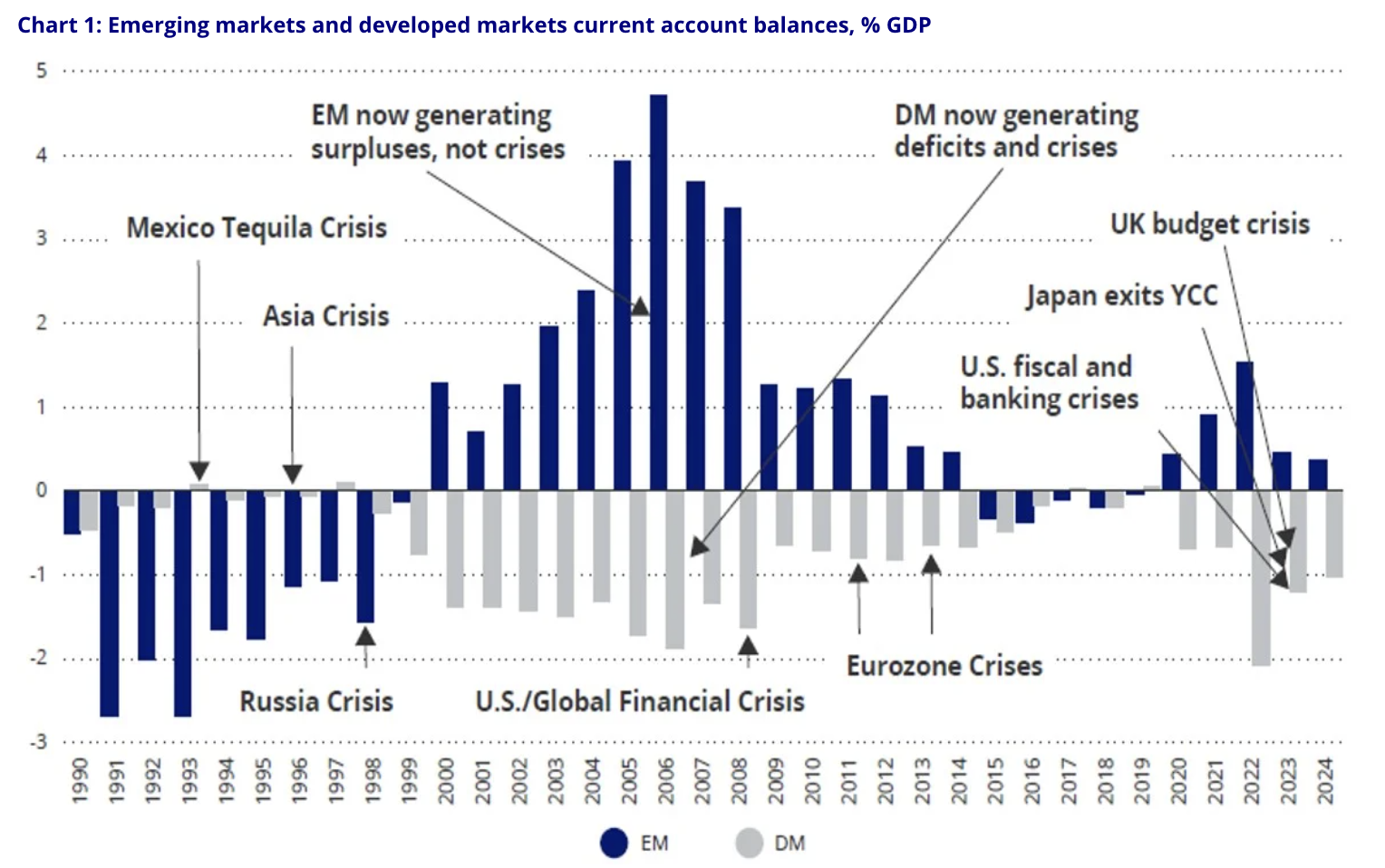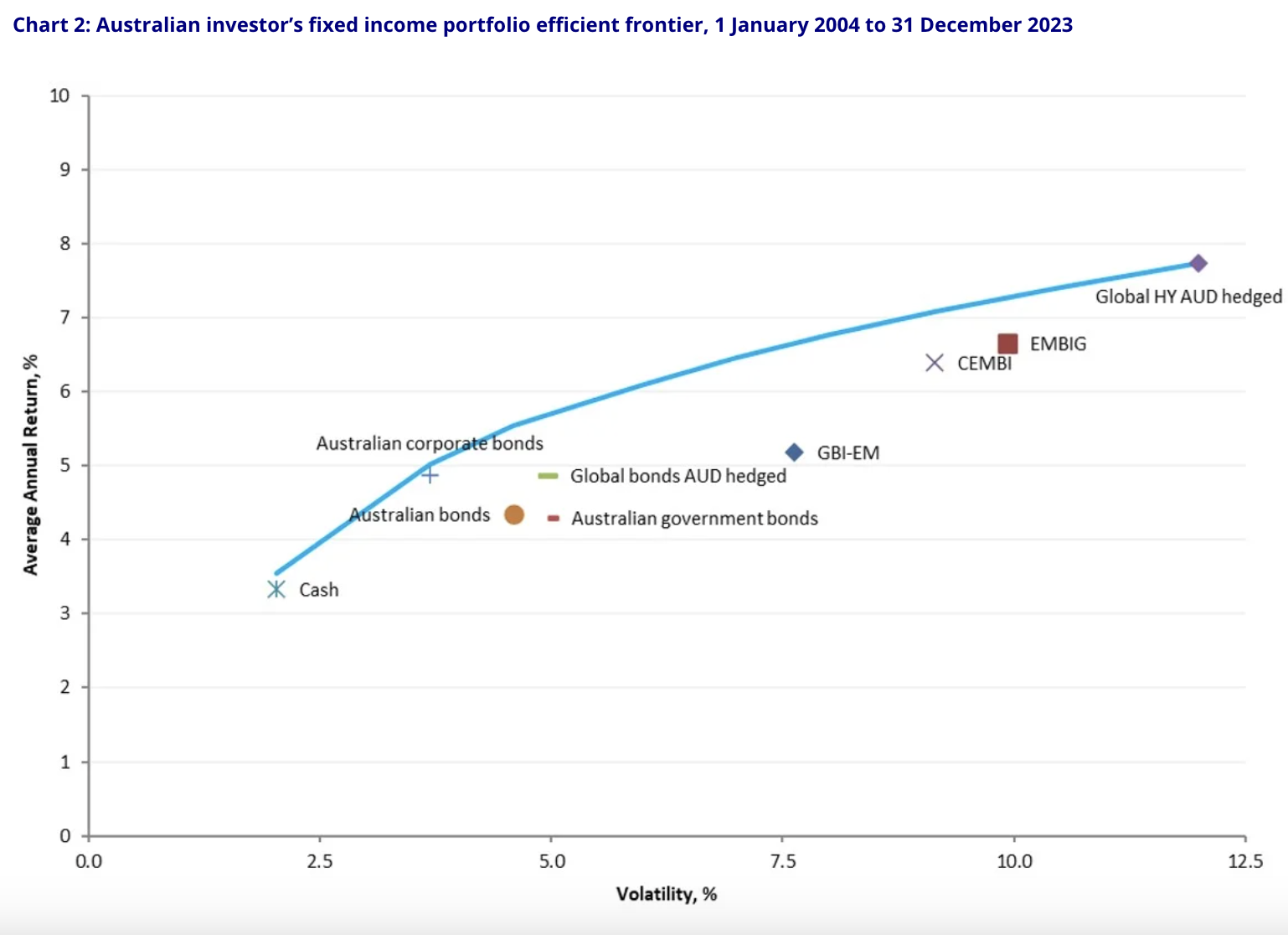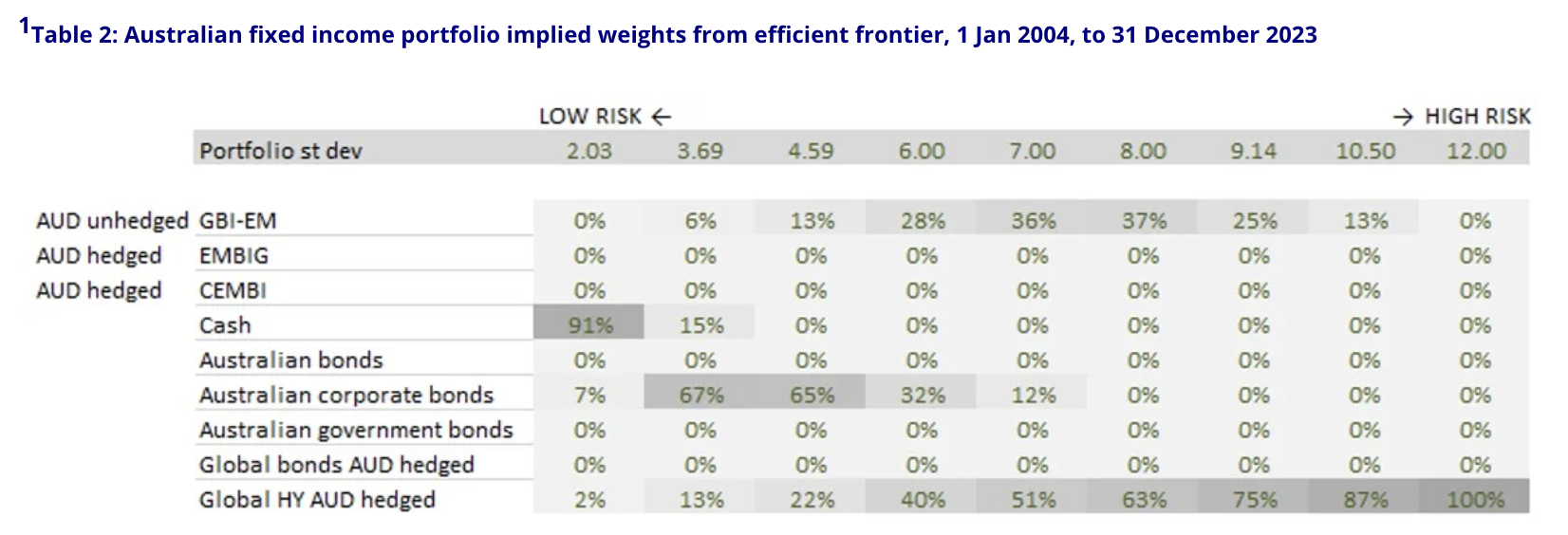This asset class could reap dividends for your portfolio for another 20 years
Over the past 30 years, a shift has occurred. Emerging markets economies have gone from being in deficit to running up surpluses. At the same time, developed market economies have been accruing deficits. The outcome of this has been a shift in the origination of bond crises. Before the end of the century, bond crises were a feature of emerging markets. Since 1998, all financial crises have involved the large DMs.

Source: Bloomberg, 31 December 2023
If we look back at those 25 years, the result has been that emerging markets bonds have outperformed developed markets bonds and many investors’ portfolios were not positioned for this reality.
When we launched the VanEck Emerging Income Opportunities ETF Active ETF (Managed Fund) (ASX: EBND) at the start of 2020, we produced a paper that analysed fixed income options using a tool made famous by Modern Portfolio Theory (MPT), the Efficient Frontier.
The paper found that for a moderate level of risk, say 5% to 9%, the efficient frontier analysis suggested “that the majority of a fixed income portfolio should be invested in emerging markets hard currency bonds (represented by EMBIG).”
Below is an update of the data presented in the 2020 paper.

Source: Bloomberg, VanEck, 31 December 2023. Results are calculated annually and assume immediate reinvestment of all dividends. Volatility is the Standard Deviation of returns. You cannot invest in an index. Past performance is not a reliable indicator of future performance. Indices used: Cash – Bloomberg Australian Bank Bill 0+ Yr Index; Global Bonds AUD hedged – Barclays Global Aggregate Bond Index A$ Hedged; Australian Bonds – Bloomberg AusBond Composite Index; Australian corporate bonds – Bloomberg AusBond Credit 0+Yr Index; Australian government bonds – Bloomberg AusBond Australia Government Bond; GBI-EM is EM local - J.P. Morgan Government Bond Index-Emerging Markets Global Diversified (GBI-EM); EMBIG is EM hard currency - J.P Morgan Emerging Markets Bond Index Global Diversified (EMBIGD) – EMBIGD is unhedged, EBND hedges its hard currency; CEMBI – J.P Morgan Corporate Emerging Markets Bond Index (CEMBI); Global HY AUD hedged – Bloomberg Barclay Global High Yield Index A$ Hedged.
In short, the maths suggests that like in 2020, that fixed income portfolios should have sizeable allocations to emerging markets bonds. From a diversification point of view, the evidence suggests that an allocation of more than zero is appropriate for emerging markets bonds.
We believe it is not too late for investors to include or increase their allocation to emerging markets bonds for long-term portfolios. This wire will examine why we think this is the case, with the help of some academic research.
What is fiscal dominance?
Fiscal dominance is an economic condition that arises when debts and deficits are so high that monetary policy loses traction.
A feature of fiscal dominance is government debt.
20 years ago, fiscal dominance may have characterised emerging market economies. Now, it appears to characterise developed markets and the shift in this dynamic is reflective of the performance of bond markets. Emerging markets bonds have outperformed developed markets bonds over the past 20 years.
The new stars of bond markets
Emerging market economies came to the fore during the global crisis in 2008/2009. Many emerging markets economies came out of the GFC structurally stronger than their developed market counterparts. Several EM governments were able to better implement counter-cyclical fiscal expansion to reignite growth because of their growing foreign exchange reserves, strong budgets and robust balance of payments. Emerging markets were part of the answer to stimulate global growth.
China, for example, was able to increase fiscal and monetary stimulus in response to the crisis. In the old days, they would have had to do the exact opposite, bunkering down and tightening, to then suffer a much worse crisis.
Some emerging markets countries didn't even go through a recession during the GFC. Emerging markets also successfully navigated 2013’s ‘taper tantrum’ and were the stars of the more recent COVID crisis and subsequent rate hiking cycle.

The taper tantrum experience proved that emerging markets were no longer dependent on US dollar debt. A similar episode may well have crippled some emerging markets in the 1990s because they didn’t have the reserves.
During the recent rating hiking cycle emerging markets, we would argue were the rate-hiking champions. The recent global tightening cycle was led by emerging markets, which started hiking earlier and larger than the Fed and RBA to address rising inflation pressures. As a result, EM economies had, for the most part, a smoother hiking cycle because they had already started easing.
It's time to re-think allocation
And while many fixed income portfolios remain underweight emerging markets, we think it's only a matter of time before more and more investors will start to include them in their portfolios.
Because of the idiosyncrasies between the nations included in the emerging markets universe and the nuances between the different types of bonds available, we think an active, unconstrained approach is an ideal way for investors to access this important asset class.

Source: Bloomberg, VanEck, 31 December 2023. Results are calculated annually and assume immediate reinvestment of all dividends. Volatility is the Standard Deviation of returns. You cannot invest in an index. Past performance is not a reliable indicator of future performance. Indices used: Cash – Bloomberg Australian Bank Bill 0+ Yr Index; Global Bonds AUD hedged – Barclays Global Aggregate Bond Index A$ Hedged; Australian Bonds – Bloomberg AusBond Composite Index; Australian corporate bonds – Bloomberg AusBond Credit 0+Yr Index; Australian government bonds – Bloomberg AusBond Australia Government Bond; GBI-EM is EM local - J.P. Morgan Government Bond Index-Emerging Markets Global Diversified (GBI-EM); EMBIG is EM hard currency - J.P Morgan Emerging Markets Bond Index Global Diversified (EMBIGD) – EMBIGD is unhedged, EBND hedges its hard currency; CEMBI – J.P Morgan Corporate Emerging Markets Bond Index (CEMBI); Global HY AUD hedged – Bloomberg Barclay Global High Yield Index A$ Hedged.
Key risks: An investment in EBND carries risks associated with: ASX trading time differences, emerging markets bonds and currencies, bond markets generally, interest rate movements, issuer default, currency hedging, credit ratings, country and issuer concentration, liquidity, fund manager and fund operations. See the PDS for details.

